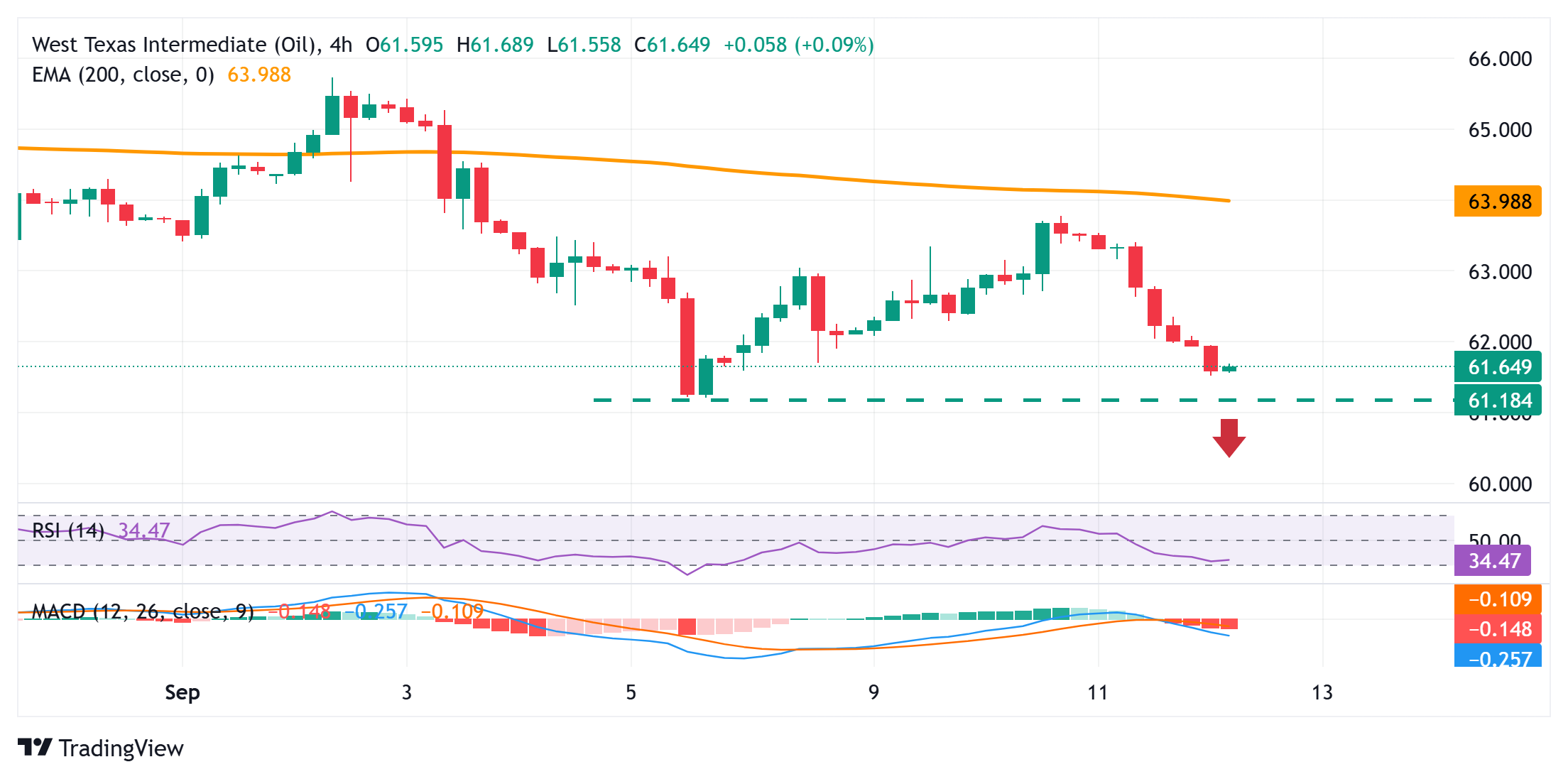WTI Price Forecast: Slides closer to mid-$61.00s, eyes multi-month low amid bearish setup
- WTI drifts lower for the second straight day and slides back closer to a multi-month low.
- Weak demand and oversupply concerns weigh on the commodity despite geopolitical risks.
- Some follow-through slide below the $61.25 area should pave the way for further losses.
West Texas Intermediate (WTI) US Crude Oil prices attract some follow-through selling for the second straight day and drop to a fresh weekly low, closer to mid-$61.00s during the Asian session on Friday.
An unexpected rise in US crude inventories pointed to softening demand. Moreover, the OPEC+ decision to increase production from October raised oversupply concerns, which continue to weigh on Crude Oil prices. Meanwhile, the downfall seems rather unaffected by the risk of a further escalation of geopolitical tensions amid the protracted Russia-Ukraine war and conflicts in the Middle East.
The commodity has now moved within striking distance of a three-month low, around the $61.25 area touched last week. Some follow-through selling, leading to a subsequent break below the $61.00 mark, will be seen as a fresh trigger for bearish traders and drag Crude Oil prices to the $60.60 support zone. The downward trajectory might then drag the black liquid to the $60.00 psychological mark.
On the flip side, any meaningful recovery attempt beyond the $62.00 immediate hurdle is likely to confront stiff resistance and remain capped near the $62.55-$62.60 region. A sustained strength beyond, however, could trigger a short-covering rally and allow Crude Oil prices to reclaim the $63.00 mark. Bulls might then aim to test the monthly top, around the $63.75-$63.80 region touched last week.
WTI 4-hour chart

WTI Oil FAQs
WTI Oil is a type of Crude Oil sold on international markets. The WTI stands for West Texas Intermediate, one of three major types including Brent and Dubai Crude. WTI is also referred to as “light” and “sweet” because of its relatively low gravity and sulfur content respectively. It is considered a high quality Oil that is easily refined. It is sourced in the United States and distributed via the Cushing hub, which is considered “The Pipeline Crossroads of the World”. It is a benchmark for the Oil market and WTI price is frequently quoted in the media.
Like all assets, supply and demand are the key drivers of WTI Oil price. As such, global growth can be a driver of increased demand and vice versa for weak global growth. Political instability, wars, and sanctions can disrupt supply and impact prices. The decisions of OPEC, a group of major Oil-producing countries, is another key driver of price. The value of the US Dollar influences the price of WTI Crude Oil, since Oil is predominantly traded in US Dollars, thus a weaker US Dollar can make Oil more affordable and vice versa.
The weekly Oil inventory reports published by the American Petroleum Institute (API) and the Energy Information Agency (EIA) impact the price of WTI Oil. Changes in inventories reflect fluctuating supply and demand. If the data shows a drop in inventories it can indicate increased demand, pushing up Oil price. Higher inventories can reflect increased supply, pushing down prices. API’s report is published every Tuesday and EIA’s the day after. Their results are usually similar, falling within 1% of each other 75% of the time. The EIA data is considered more reliable, since it is a government agency.
OPEC (Organization of the Petroleum Exporting Countries) is a group of 12 Oil-producing nations who collectively decide production quotas for member countries at twice-yearly meetings. Their decisions often impact WTI Oil prices. When OPEC decides to lower quotas, it can tighten supply, pushing up Oil prices. When OPEC increases production, it has the opposite effect. OPEC+ refers to an expanded group that includes ten extra non-OPEC members, the most notable of which is Russia.
